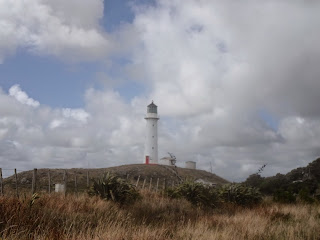Heading south from new Plymouth, you can either take Highway 3 towards Wellington, which goes through farmland and gently rolling hills (slightly reminiscent of the Ozarks and Southern Missouri), or take Highway 45 (also known as the Surf Highway) which follows the coast. One sunny weekend day a fellow American friend and I grabbed a guidebook and a map and headed down the Surf Highway. We had loosely decided to look for some lighthouses which we had vaguely heard mention of, and wanted to attempt to find a shipwreck that you can see from one of the beaches. Really we were looking forward to a mini adventure and enjoying what might be one of the last sunny days before the end of summer. It turned out to be preparation for me playing tour guide to my sister and her husband when they visited since we ended up having extra time to enjoy the sights of Taranaki.
We visited two lighthouses. The first was the Cape Egmont Lighthouse. This lighthouse was first erected in 1865 North of Wellington. In 1881 it was moved in pieces by steamer to Cape Egmont after its previous station was closed due to too many shipwrecks. The lighthouse is 20 meters tall (65 feet) and 33 meters(108 feet) above sea-level. The light flashes every 8 seconds and can be seen for 19 nautical miles, or 35 kilometers (21.7 miles). The lighthouse keeper was withdrawn in 1986 and the lighthouse has been fully automated since then, being operated by computer and maritime staff in Wellington.
 |
| View of the cost from the lighthouse steps |
The second lighthouse was a smaller one, although I could not find the name for it. It was erected as a memorial to those who served in the first and second world wars, and has been converted to a museum, although it does still function as a lighthouse as well. We were able to go to the top of this one and see the impressive light :)
 |
| Plaque by the entrance |
 |
| The modern light |
 |
| View from the top |
Our last stop of the day was the shipwreck. What is left on the rocky beach was once the starboard bow of the SS Gairloch. A bit further out you can also see rusty bits of the engine and boiler. The SS Gairloch was a steamer that met its end in the middle of the night on January 5, 1903. The ship was traveling from Onehunga to Wanganui, and reportedly had nearly collided with another ship shortly before it found itself stranded on the rocks of the Timaru Reef. None of the crew were injured and once day hit, they were able to return to the wreck with the
aid of local folks and collect the crews possessions. The cargo on board at the time was sugar, flour, cement, drain pipes, and two carriages. Nearly all of it was salvaged. Once the cargo was removed, the wreck was sold to a local for £20, after which he proceeded to salvage as much of the ships machinery as possible. The ship had been built in 1884 and was a steel three-masted steamer weighing 373 tons, with a length of 164 feet. It was powered by two 85 horsepower engines and had a maximum speed of 11 knots. There was space for up to 20 passengers and could carry 340 tons of cargo. The Captain on board the night of the wreck was sent to an inquiry in Auckland. His certificate was suspended for 3 months as it was found he had made an error in judgement by being too close to land on such a dark night, and had to pay part of the cost of the inquiry.
.jpg) |
| Sugar loaf islands |
 |
| The ships boiler |




.jpg)


























